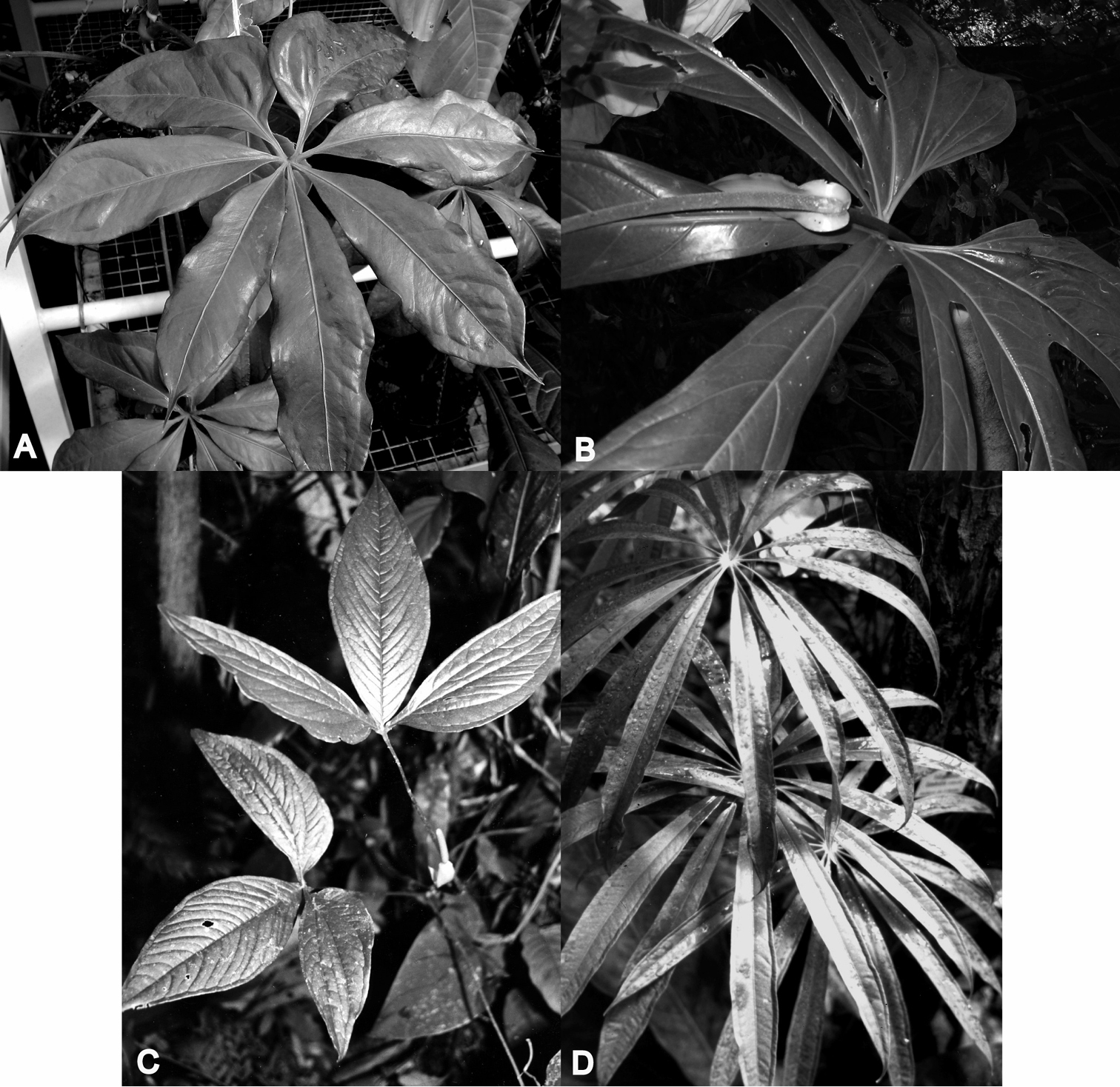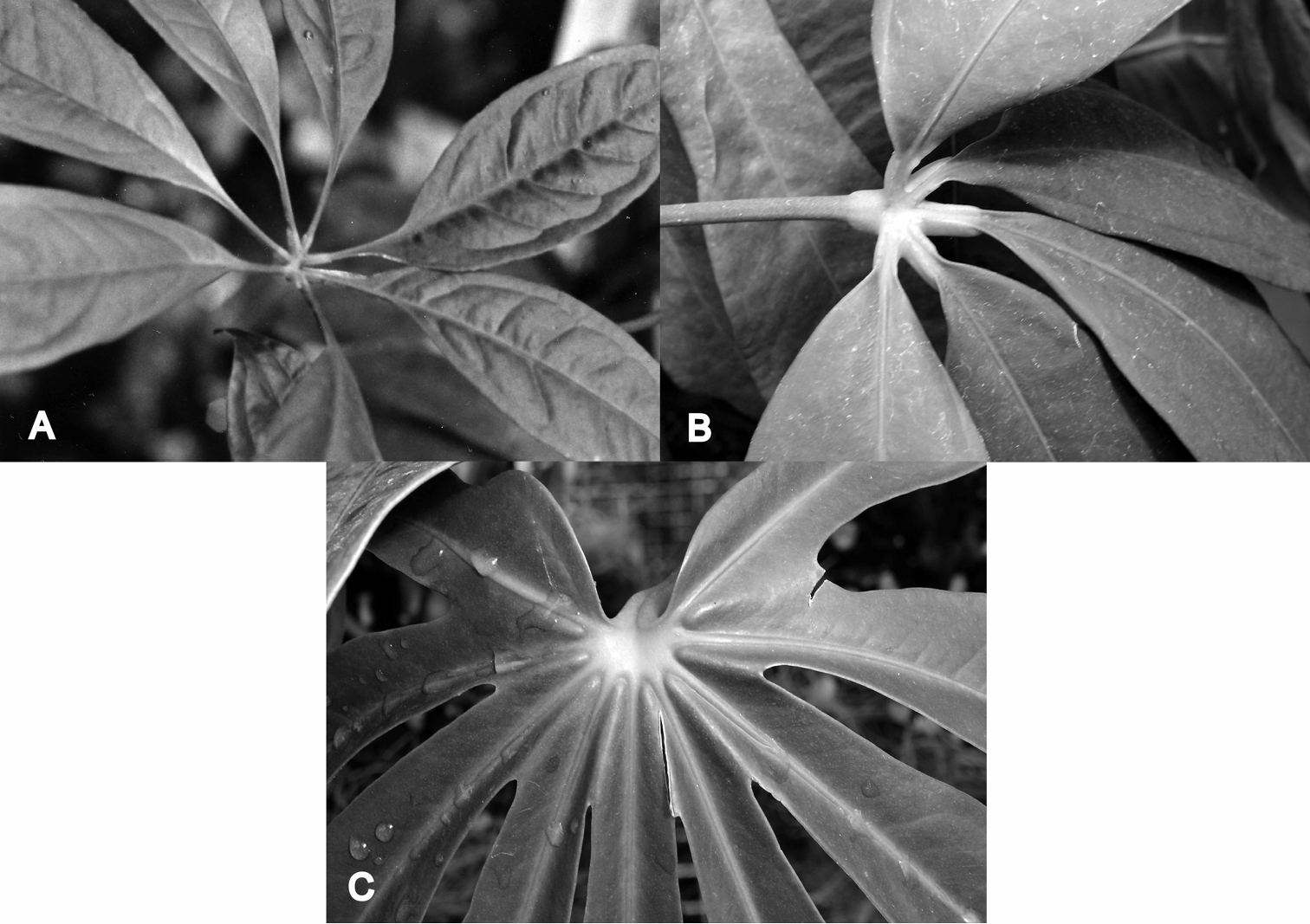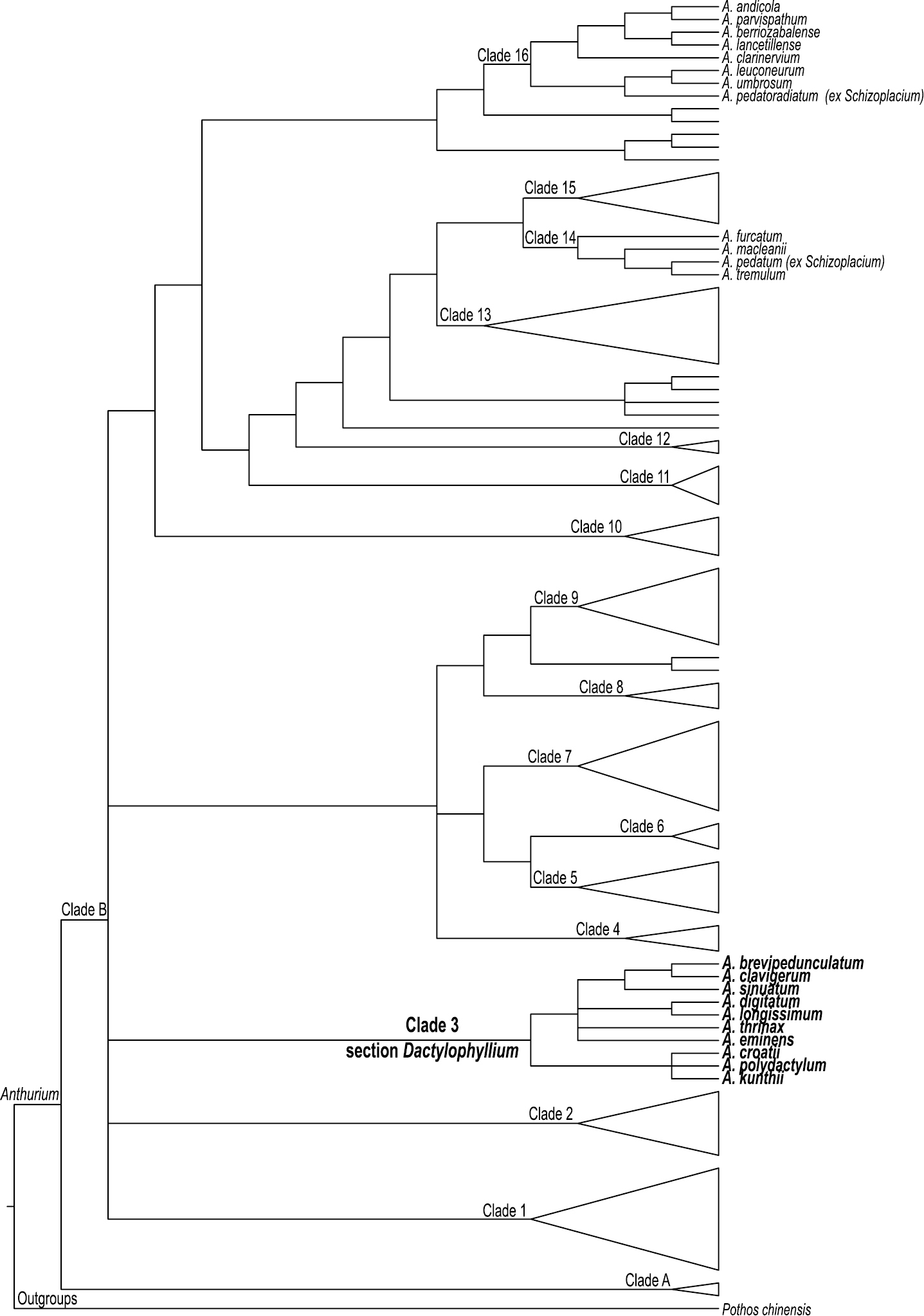






(C) 2013 Thomas B. Croat. This is an open access article distributed under the terms of the Creative Commons Attribution License 3.0 (CC-BY), which permits unrestricted use, distribution, and reproduction in any medium, provided the original author and source are credited.
For reference, use of the paginated PDF or printed version of this article is recommended.
A reappraisal is made of the Anthurium Schott species with palmately divided leaves with 3 or more segments free to the base (i.e. palmatisect leaves), previously recognized as section Dactylophyllium Schott (Engler), as well as those species with 5 or more segments united at the base (i.e. palmatifid leaves), formerly placed in section Schizoplacium Schott (Engler). New molecular data indicates that several species (Anthurium pedatum (Kunth) Schott, Anthurium pedatoradiatum Schott, and possibly, Anthurium podophyllum (Schltdl. & Cham.) Kunth) should be excluded from section Schizoplacium, and other species previously placed in that section cannot be separated from section Dactylophyllium. Thus, Anthurium section Schizoplacium is here synonymized within section Dactylophyllium and type species are designated for both groups. This paper also provides an updated description of section Dactylophyllium as here emended, listing the 24 accepted taxa now included (20 species and 4 varieties or subspecies), along with their geographic distributions.
Anthurium, molecular phylogeny, palmately divided leaves, palmatisect leaves, palmatifid leaves, section Schizoplacium, sectional classification
Anthurium Schott species with palmately divided leaves (as included in
Examples of Anthurium species with palmately divided leaves here included in section Dactylophyllium (Schott) Engler emend. Croat & Carlsen. A Palmatisect leaf with seven leaflets of Anthurium pentaphyllum (Aubl.) G.Don var. pentaphyllum (M. Leppard 1395) B Palmatifid leaf of Anthurium longissimum Pittier ssp. longissimum (M. Carlsen 2126) C Palmatisect leaves with three leaflets of Anthurium trisectum Sodiro (T.B. Croat 48977) D Palmatisect leaves with more than 9 leaflets of Anthurium polydactylum Madison (T.C. Plowman & H. Kennedy 5769).
Detail of leaf bases of Anthurium species with palmately divided leaves. A Palmatisect leaf with segments (leaflets) free to the base with long petiolules, Anthurium kunthii Poepp. var. kunthii (J.P. Folsom 3228) B Palmatisect leaf with segments (leaflets) free to the base with short petiolules, Anthurium pentaphyllum (Aubl.) G.Don var. pentaphyllum (R.M. Harley 18334) C Palmatifid leaf with segments (lobes) united at the base, Anthurium palmatum (L.) Schott (Kew living collection 1980-554).
A schematic molecular phylogeny of Anthurium showing major clades recovered by
In the first comprehensive revision of the genus,
Anthurium species with palmately divided leaves formerly included in Dactylophyllium and Schizoplacium, a comparison of previous circumscriptions. This is not an exhaustive list of all species names that have been previously included in these groups, it only contains taxa that were accepted at the time of publication of each work. Names in bold denote species included in the newly redefined section Dactylophyllium (Schott) Engler emend. Croat & Carlsen, as proposed here. Species marked with (*) are now formally excluded from this emended section. All other species names are either synonyms or species dubia, fide
| Species name | Year published | ||||
|---|---|---|---|---|---|
| Anthurium aemulum Schott | 1859 | Dactylophyllium | Schizoplacium series Dactylophyllium | synonym of Anthurium pentaphyllum var. bombacifolium |
|
| Anthurium andersonii Schott | 1857 | Dactylophyllium | Schizoplacium series Dactylophyllium | synonym of Anthurium palmatum |
|
| (*) Anthurium angustisectum Engl. | 1898 | Group 6 | Schizoplacium | ||
| Anthurium araliaefolium Regel | 1869 | Schizoplacium series Euschizoplacium | species dubium, probably a hybrid | ||
| Anthurium arisaemoides Madison | 1978 | Group 7 Schizoplacium |
Dactylophyllium | ||
| Anthurium aubletii Kunth | 1841 | Dactylophyllium | synonym of Anthurium pentaphyllum |
synonym of Anthurium pentaphyllum var. pentaphyllum |
|
| Anthurium bombacifolium Schott | 1858 | Dactylophyllium | synonym of Anthurium aemulum |
Anthurium pentaphyllum var. bombacifolium | |
| Anthurium brevipedunculatum Madison | 1978 | Group 7 Schizoplacium |
Dactylophyllium | ||
| Anthurium buchtienii K. Krause | 1910 | Group 7 Schizoplacium |
Dactylophyllium | ||
| Anthurium clavigerum Poepp. | 1845 | Dactylophyllium | Semaeophyllium | Group 7 Schizoplacium |
Dactylophyllium |
| Anthurium clavigerum var. subpedatipartitum Engl. | 1905 | Semaeophyllium | not mentioned | ||
| Anthurium croatii Madison | 1978 | Group 7 Schizoplacium |
Dactylophyllium | ||
| Anthurium digitatum (Jacq) Schott | 1829 | Dactylophyllium | Schizoplacium series Dactylophyllium | Anthurium pentaphyllum var. digitatum Group 7 Schizoplacium |
not mentioned |
| Anthurium elegans Engl. | 1881 | Schizoplacium series Euschizoplacium | synonym of Anthurium palmatum |
||
| Anthurium eminens Schott | 1855 | Dactylophyllium | Schizoplacium series Dactylophyllium | Group 7 Schizoplacium |
Dactylophyllium |
| Anthurium expansum Gleason | 1929 | Group 6 | Schizoplacium | ||
| Anthurium fissum K. Koch | 1864 | Semaeophyllium | synonym of Anthurium palmatum |
||
| Anthurium ghiesbrechtii Linden ex Schott | 1860 | Schizoplacium | synonym of Anthurium podophyllum |
not mentioned | |
| Anthurium grossum Schott | 1859 | Dactylophyllium | Anthurium pentaphyllum var. grossum | synonym of Anthurium pentaphyllum var. pentaphyllum |
|
| Anthurium helleborifolium Schott | 1862 | Schizoplacium series Euschizoplacium | synonym of Anthurium pedatoradiatum |
||
| Anthurium hoffmannseggii Schott | 1857 | Dactylophyllium | synonym of Anthurium pentaphyllum |
synonym of Anthurium kunthii |
|
| Anthurium holtonianum Schott | 1857 | Dactylophyllium | Semaeophyllium | synonym of Anthurium clavigerum |
|
| Anthurium holtonianum var. cohaerens Engl. | 1905 | Semaeophyllium | not mentioned | ||
| Anthurium kalbreyeri Mast. | 1881 | Schizoplacium series Dactylophyllium | synonym of Anthurium clavigerum |
||
| Anthurium karwinskii Schott | 1859 | Dactylophyllium | synonym of Anthurium aemulum |
synonym of Anthurium pentaphyllum var. bombacifolium |
|
| Anthurium kunthii Poepp. | 1845 | Dactylophyllium | Schizoplacium series Dactylophyllium | Group 7 Schizoplacium |
Dactylophyllium |
| Anthurium longissimum Pittier | 1947 | Group 6 | Schizoplacium | ||
| Anthurium martini Schott | 1857 | Dactylophyllium | Semaeophyllium | synonym of Anthurium sinuatum |
|
| Anthurium ottonianum Kunth | 1841 | Dactylophyllium | Anthurium variabile var. ottonianum | not mentioned | |
| Anthurium pachirifolium Schott | 1855 | Dactylophyllium | Schizoplacium series Dactylophyllium | synonym of Anthurium pentaphyllum var. pentaphyllum |
|
| Anthurium pachirifolium var. angustifolium Engl. | 1881 | Schizoplacium series Dactylophyllium | synonym of Anthurium pentaphyllum var. pentaphyllum |
||
| Anthurium palmatum (L.) Schott | 1829 | Schizoplacium | Semaeophyllium | Group 6 | Schizoplacium |
| Anthurium panduratum Mart. ex Schott | 1855 | Dactylophyllium | Semaeophyllium | synonym of Anthurium clavigerum |
|
| Anthurium panduratum var. burchellianum Engl. | 1905 | Semaeophyllium | synonym of Anthurium clavigerum |
||
| (*) Anthurium pedatoradiatum Schott | 1859 | Schizoplacium | Schizoplacium series Euschizoplacium | Group 4 | Schizoplacium |
| (*) Anthurium pedatum (Kunth) Schott | 1829 | Schizoplacium | Schizoplacium series Euschizoplacium | Group 5 | Schizoplacium |
| Anthurium pentaphyllum (Aubl.) G. Don | 1839 | Dactylophyllium | Schizoplacium series Dactylophyllium | Group 7 Schizoplacium |
Dactylophyllium |
| Anthurium pentaphyllum var. bombacifolium (Schott) Madison | 1978 | Group 7 Schizoplacium |
Dactylophyllium | ||
| (*) Anthurium podophyllum (Schltdl. & Cham.) Kunth | 1841 | Schizoplacium | Schizoplacium series Euschizoplacium | Group 4 | Schizoplacium |
| Anthurium polydactylum Madison | 1978 | Group 7 Schizoplacium |
Dactylophyllium | ||
| Anthurium polyschistum R.E. Schultes & Idrobo | 1959 | Group 7 Schizoplacium |
Dactylophyllium | ||
| Anthurium polytomum Schott | 1859 | Schizoplacium | synonym of Anthurium podophyllum |
synonym of Anthurium podophyllum |
|
| Anthurium pseudopodophyllum Schott | 1859 | Schizoplacium | synonym of Anthurium podophyllum |
synonym of Anthurium podophyllum |
|
| Anthurium repandum Schott | 1857 | Dactylophyllium | Semaeophyllium | synonym of Anthurium clavigerum |
|
| Anthurium sinuatum Benth ex Schott | 1857 | Dactylophyllium | Semaeophyllium | Group 7 Schizoplacium |
not mentioned |
| Anthurium smilaciforme K. Koch | 1855 | Dactylophyllium | synonym of Anthurium undatum |
not mentioned | |
| Anthurium sonderianum Schott | 1858 | Dactylophyllium | synonym of Anthurium pentaphyllum |
synonym of Anthurium pentaphyllum var. pentaphyllum |
|
| Anthurium sylvestre S. Moore | 1895 | Semaeophyllium | synonym of Anthurium sinuatum |
||
| Anthurium thrinax Madison | 1978 | Group 7 Schizoplacium |
Dactylophyllium | ||
| Anthurium triphyllum (Willd. ex Schult.) Brongn. ex Schott | 1860 | Dactylophyllium | Schizoplacium series Dactylophyllium | Group 7 Schizoplacium |
Dactylophyllium |
| Anthurium trisectum Sodiro | 1905 | Group 7 Schizoplacium |
Dactylophyllium | ||
| Anthurium undatum Schott | 1832 | Dactylophyllium | Schizoplacium series Dactylophyllium | synonym of Anthurium pentaphyllum var. pentaphyllum |
|
| Anthurium undatum var. undulifolium (K. Koch ex Ender) Engl. | 1878 | Schizoplacium series Dactylophyllium | not mentioned | ||
| Anthurium undulatum K. Koch & C. D. Bouché | 1854 | Dactylophyllium | synonym of Anthurium undatum var. undulifolium |
not mentioned | |
| Anthurium variabile Kunth | 1841 | Dactylophyllium | Schizoplacium series Dactylophyllium | synonym of Anthurium pentaphyllum var. pentaphyllum |
|
| Anthurium warscewiczii K. Koch | 1855 | Dactylophyllium | synonym of Anthurium sinuatum |
not mentioned | |
| Anthurium wendlandii Schott | 1858 | Dactylophyllium | Semaeophyllium | synonym of Anthurium clavigerum |
However,
The last taxonomic revision of Anthurium species with palmately divided leaves (
The current molecular phylogeny of the genus Anthurium, based on chloroplast (trnG intron, trnH–psbA and trnC–ycf6 intergenic spacers) and nuclear (first intron of CHS and partial flanking coding regions) DNA sequences (
Based on this molecular phylogeny (
Anthurium pedatoradiatum, a Mexican species with palmatifid leaves and a member of section Schizoplacium (fide
There are only four currently recognized species names included in the original description of Schott’s grex Schizoplacium (
The molecular phylogeny of Anthurium (
In terms of nomenclatural choice, since both names, Schizoplacium and Dactylophyllium, were published, albeit without a formal rank (i.e. as grex names), at the same time in
Anthurium kunthii (Fig. 2A) is here chosen as the lectotype for this emended section Dactylophyllium for several reasons. Anthurium kunthii was among the original species included in
The following section provides an updated description of Anthurium section Dactylophyllium (Schott) Engler, emend. Croat & Carlsen, and lists all currently recognized species now comprising this group and their known geographic distribution.
Mostly appressed-climbing or scandent plants with internodes usually longer than broad, or terrestrial short stemmed plants; roots moderately sparse at each node on climbing plants, sometimes moderately dense on terrestrial species with short internodes; cataphylls usually persisting as fibers, sometimes deciduous, rarely persisting intact, the cataphyll fibers typically pale, sometimes dark reddish brown; petioles typically subterete, usually at least weakly sulcate adaxially, typically drying greenish to gray-green, sometimes dark brown; blades palmately divided and deeply lobed with 5–7 lobes united at the base (i.e. palmatifid leaves) (Figs 1B, 2C) (Anthurium expansum, Anthurium longissimum, and Anthurium palmatum) or palmatisect with segments (leaflets) divided completely to base and free (Fig. 2A–B), sometimes 3-sect (Fig. 1C) (Anthurium arisaemoides Madison, Anthurium thrinax Madison, Anthurium triphyllum, and Anthurium trisectum Sodiro), more commonly 5–11-sect (Fig. 1A, D) (Anthurium brevipedunculatum Madison, Anthurium clavigerum, Anthurium croatii Madison, Anthurium eminens, Anthurium kunthii, Anthurium pentaphyllum, Anthurium polyschistum R.E. Schultes & Idrobo, and Anthurium sinuatum), the petiolules of each segment short or long (Fig. 2A–B), the segments usually entire, sometimes sinuate (Anthurium clavigerum, Anthurium sinuatum) or weakly to strongly pinnately lobed (Anthurium clavigerum); the medial segment or lobe largest; side segments or lobes diminishing in size; juvenile blades simple; leaf surface usually smooth, glabrous, generally drying greenish, sometimes yellow-brown or dark brown; midrib typically raised on both surfaces; primary lateral veins typically conspicuous, usually well spaced, weakly raised or sunken above, usually narrowly rounded and prominently raised below; tertiary veins typically visible, sometimes moderately well-raised beneath. INFLORESCENCE short- (Anthurium brevipedunculatum, Anthurium pentaphyllum) or more commonly long-pedunculate; spathe typically green, spreading, sometimes ovate and erect (Anthurium brevipedunculatum), usually persistent; spadix green to purplish violet, usually long-tapered, sometimes short-tapered. FRUITS purple, violet-purple or reddish-purple berries.
Species of Anthurium included in section Dactylophyllium, under this revised delimitation, are mainly distributed in the Amazon lowlands, with a few widespread species ranging into Central America (Anthurium clavigerum, Anthurium kunthii, and Anthurium trisectum), and into the Atlantic coast of South America to Brazil (Anthurium pentaphyllum). Three taxa have disjunct distributions in the coastal mountain ranges of the Cordillera Central of Venezuela (Anthurium digitatum and Anthurium longissimum) and the Lesser Antilles (Anthurium palmatum).
Presently, 24 accepted taxa (20 species and 4 varieties or subspecies) occur in section Dactylophyllium as emended here. These taxa and their geographic distribution are as follow:
Anthurium arisaemoides Madison (Ecuador, Peru)
Anthurium brevipedunculatum Madison (Bolivia, Brazil, Colombia, Ecuador, Peru)
Anthurium buchtienii K.Krause (Bolivia)
Anthurium clavigerum Poepp. (widespread, Nicaragua to Venezuela and Peru)
Anthurium croatii Madison (Bolivia, Brazil, Colombia, Ecuador, Peru)
Anthurium digitatum (Jacq.) Schott (Venezuela)
Anthurium eminens Schott var. eminens (Bolivia, Brazil, Colombia, Ecuador, French Guiana)
Anthurium eminens Schott var. longispadix Croat & M.Mora (Colombia)
Anthurium expansum Gleason (French Guiana, Guyana, Suriname, Venezuela)
Anthurium kunthii var. cylindricum Croat (Bolivia)
Anthurium kunthii Poepp. var. kunthii (Costa Rica to Peru and Bolivia) (Fig. 2A)
Anthurium longissimum Pittier ssp. longissimum (Venezuela) (Fig. 1B)
Anthurium longissimum Pittier ssp. nirguense Bunting (Venezuela)
Anthurium moonenii Croat & E.G.Gonçalves (French Guiana)
Anthurium palmatum (L.) Schott (Lesser Antilles) (Fig. 2C)
Anthurium pentaphyllum (Aubl.) G. Don var. bombacifolium (Schott) Madison (Belize, Costa Rica, Guatemala)
Anthurium pentaphyllum (Aubl.) G.Don var. pentaphyllum (widespread Costa Rica to the Guianas, Brazil and Peru) (Figs 1A, 2B)
Anthurium polydactylum Madison (Bolivia, Peru) (Fig. 1D)
Anthurium polyschistum R.E. Schultes & Idrobo (Brazil, Colombia, Ecuador, Peru)
Anthurium sinuatum Benth ex Schott (Brazil, French Guiana, Suriname, Venezuela)
Anthurium thrinax Madison (French Guiana, Guyana)
Anthurium triphyllum (Willd. ex Schult.) Brongn. ex Schott (Bolivia, Ecuador, Peru)
Anthurium trisectum Sodiro (Costa Rica to Ecuador) (Fig. 1C)
Anthurium zuloagae Croat (Colombia)
There are also at least four more currently undescribed species in the section, and at least two more varieties that need formal recognition. A complete taxonomic revision, including identification keys, species synonymy, descriptions and illustrative photographs, of all the species of Anthurium with palmately divided leaves comprising the newly amended section Dactylophyllium is indeed needed, but beyond the scope of this article.
This study was based, in part, on the results of the PhD dissertation of the second author, and thus MMC would like to thank Peter Stevens (Advisor), Elizabeth Kellogg, Mick Richardson and Simon Mayo for helpful discussions. This study was supported by a National Science Foundation Doctoral Dissertation Improvement Grant (DEB0709851), and graduate research grants from the Botanical Society of America, the American Society of Plant Taxonomists, the Garden Club of America, the Desmond Lee Fund at the University of Missouri–St. Louis, and the Royal Botanical Gardens in Kew, England with a Kew Latin American Research Fellowship. MMC is also thankful to the W. R. Harris World Ecology Center at the University of Missouri–St. Louis through its Christensen Fellowship, and the Missouri Botanical Garden for financial support during her doctoral studies. We would also like to thank two anonymous reviewers for their valuable suggestions to improve the original manuscript.


